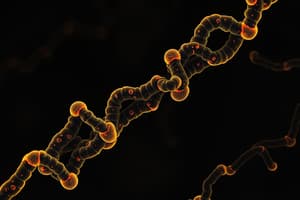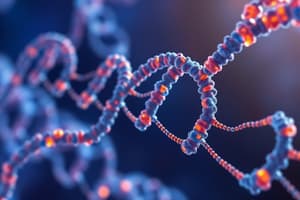Podcast
Questions and Answers
Which type of chromatin remains in a highly condensed state throughout the cell cycle?
Which type of chromatin remains in a highly condensed state throughout the cell cycle?
- Euchromatin
- Both B and C (correct)
- Facultative Heterochromatin
- Constitutive Heterochromatin
Euchromatin is characterized by being densely compacted during interphase.
Euchromatin is characterized by being densely compacted during interphase.
False (B)
What are the positively charged proteins that bind to DNA called?
What are the positively charged proteins that bind to DNA called?
Histones
Heterochromatin is relatively inactive in __________.
Heterochromatin is relatively inactive in __________.
Euchromatin can best be described as:
Euchromatin can best be described as:
Match the types of histones with their identifiers:
Match the types of histones with their identifiers:
Constitutive heterochromatin is involved in transcribing active genes.
Constitutive heterochromatin is involved in transcribing active genes.
What type of chromatin contains the majority of structural genes?
What type of chromatin contains the majority of structural genes?
Flashcards are hidden until you start studying
Study Notes
Chromosomes
- Chromosomes are the units where genes are organized.
- In eukaryotic cells, chromosomes consist of a continuous DNA double helix and associated proteins.
- The term "chromosome" comes from the Greek word for "colored thread".
Chromatin Structure
- Chromatin can be divided into two main types: euchromatin and heterochromatin.
- Euchromatin is less condensed and allows for active gene transcription.
- Heterochromatin is highly condensed and remains compacted throughout the cell cycle, even during interphase.
- Gene transcription occurs mainly in euchromatin, suggesting a link between chromatin structure and gene regulation.
Euchromatin
- Euchromatin is loosely organized, spread out, and uncoiled.
- It contains genes that are actively transcribed and replicates early in the cell cycle.
- Stains lightly using G-banding techniques.
- Contains most of the structural genes.
Heterochromatin
- Heterochromatin is tightly packed at cell division and remains compacted during interphase.
- Located mainly around the nuclear periphery and nucleolus.
- Relatively inactive in transcription.
- Replicates late during the synthesis (S) phase of mitosis.
- Two types: Constitutive Heterochromatin and Facultative Heterochromatin.
Histone Proteins and the Nucleosome
- Histones are small, alkaline proteins that bind strongly to DNA.
- There are five main types of histones: H1, H2A, H2B, H3, and H4.
- Histones are rich in arginine and lysine, positively charged amino acids that contribute to their interaction with negatively charged DNA.
Studying That Suits You
Use AI to generate personalized quizzes and flashcards to suit your learning preferences.




